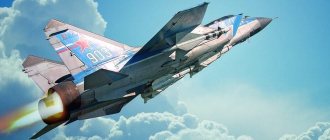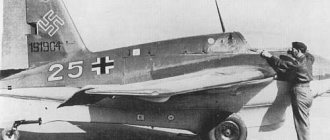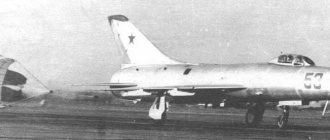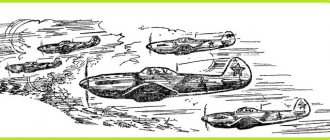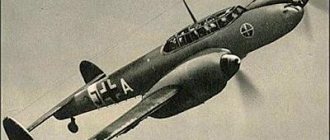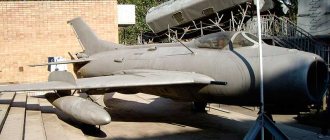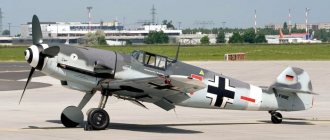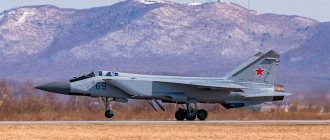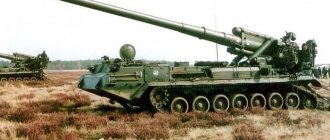The history of the creation of the MiG-31 interceptor fighter
The MiG-31 fighter-interceptor is a further development of the MiG-25P fighter-interceptor. It is intended for use in the country's air defense system, capable of carrying out long-term patrols and combating all classes of air targets (including small cruise missiles, helicopters, high-altitude high-speed aircraft and even (!) space satellites in low orbits) at any time of the day, in difficult weather conditions, when the enemy uses maneuver and sets up active and passive radar jamming and heat traps.
In 1972, the A.I. Mikoyan Design Bureau began work on an improved version of the MiG-25 fighter. Initially, the car was even called MiG-25MP. Like the MiG-25, it was an all-welded aircraft made from special alloys. The general management of development and testing was headed by General Designer R.A. Belyakov. The new aircraft is designed to combat both high-altitude and low-flying targets that have a reduced effective dispersion surface.
Unlike the prototype, the crew of the new fighter-interceptor consisted of two people; the radio-electronic equipment included a radio sight, originally developed for the long-range interceptor with variable wing geometry Tu-148, which was supposed to replace the Tu-128 aircraft.
In August 1975, a crew was assigned to the prototype MiG-31 - test pilot, chief pilot of the MiG company, Hero of the Soviet Union Alexander Vasilyevich Fedotov, leading engineer S.G. Polyakov, mechanic V.N. Kichev. On September 16, 1975, Fedotov took the car into the air for the first time, and comprehensive flight tests began, which lasted for 4 years.
MiG-31 interceptor fighter on takeoff. The characteristic dual landing gear wheels allow the heavy aircraft to take off even from airfields that do not have a good runway surface.
The test pilot himself (and Alexander Vasilyevich spent 5,000 hours in the air, performed 8,998 flights and set 18 world records!) gave the new aircraft the following assessment: “The MiG-31 has the greatest capabilities of all the aircraft that I have ever tested!” Looking ahead, it is worth noting that it was this unique aircraft that ended the life of the honored pilot. On April 4, 1984, during a test flight, an emergency situation arose, as a result of which pilot A. Fedotov and navigator V. Zaitsev died.
However, when the MiG-31 was finally put into mass production in 1979, there was absolutely no reason for sadness. In 1980, the MiG-31 began to arrive in air units, and a year later state tests of the aircraft were completed. With the adoption of this fighter, the USSR, and then Russia, received a powerful “watchdog” of air borders. Capable of destroying any targets not only close to the ground, but also reaching the upper reaches of the planet’s stratosphere, the MiG-31 is truly a unique combat vehicle.
In terms of combat capabilities, the MiG-31, even as of 2015, has no analogues abroad (and even in Russia). A special feature of the MiG-31 is “team” work. Although the aircraft is effective alone, the MiG-31's full potential is truly revealed when operating in groups of four. In this case, the exchange of information between aircraft and the ground-based automatic control system is carried out automatically, and all tasks related to searching for targets and coordinating the group are solved by on-board means that constantly receive information from the ground and interact in the group of interceptors. However, it can operate without the help of the ground, exercising control over a vast protected area with a frontal length of 900-1100 kilometers.
As for a single aircraft, it is capable of simultaneously intercepting several objects flying at different altitudes, on different courses and at different speeds. Although the MiG-31 is a heavy interceptor fighter and is not designed for maneuverable combat, it is nevertheless capable of performing all aerobatics.
In total, from 1979 to 1994, more than 500 interceptors were built, of which about 250 are currently in service with the Russian Air Force. The Kazakh Air Force also has several dozen MiG-31s; another 24 aircraft were delivered to China in the early 1990s (according to some sources).
MiG-31 interceptor fighter
Currently, about 100 MiG-31s have been modernized and completely re-equipped in accordance with modern air defense system requirements, the rest are planned to be written off due to wear and tear. At the same time, in the near future it is possible to re-launch one of the latest modifications of the aircraft into mass production to replenish the aircraft fleet.
Chronology of creation
The beginning of the creation of the Mig-31 should be considered 1968. The prototype Mig-31 made its first flight in 1975. Testing of the aircraft at the state level was completed in 1980. By 1981, all the necessary documentation, working drawings were prepared, factory equipment was manufactured and mass production technologies were developed. This made it possible to begin production of serial vehicles in the same year (Nizhny Novgorod). The fighter's first combat duty took place in 1983. Production of 31 MIGs was discontinued in 1994, after more modern aircraft models entered service.
Mig-31 in 1975
In total, more than 500 copies of the Mig-31 and its variants were manufactured.
MiG-31 interceptor fighter - differences from the MiG-25
Externally, the MiG-31 is very similar to its ancestor, the “twenty-fifth” - two fins, two sloping air intakes on the sides of the fuselage. But then the differences begin, and quite significant ones at that. First of all, it is striking that the MiG-31 has a second cockpit behind the pilot’s cockpit, while the “twenty-fifth” was single-seat. The operation of an aircraft with a fairly impressive take-off weight at conventional airfields forced a change in the design of the landing gear: for the first time, two-wheeled bogies were used on a fighter aircraft, on which the wheels were located in a so-called “spaced tandem”, which reduced the pressure on the runway surface.
The power supply of the aircraft was increased due to the installation of two modified, highly efficient, turbojet, bypass D-30 engines, developing a thrust of 15,500 kg at full afterburner - almost a third more than on the “twenty-fifth”. Unlike other interceptors, the MiG-31 is capable of being refueled several times in flight from flying tankers, significantly increasing the range and flight time.
Predecessor of the MiG-31, MiG-25. It’s quite easy to confuse them externally if you don’t know about the peculiarities of the chassis (as discussed above) and the single-seat cabin of the MiG-25, versus the double cabin of the MiG-31
The new fighter was equipped with an anti-jamming system that ensures reliable interception of air targets. It consists of an airborne radar station with a phased array antenna (used on an aircraft for the first time in the world), a heat direction finder for the forward hemisphere and a tactical situation indicator. Since it became more difficult for the pilot to simultaneously control the vehicle, weapons and sighting and navigation equipment, a navigator-operator was added to the crew.
The MiG-31 also has data transmission equipment designed for interaction between groups of four aircraft in flight in formation, target distribution and coordination of attacks. It allows you to simultaneously track up to ten targets and launch guided missiles at four at once.
As is known, the combat effectiveness of an aircraft depends on the composition and capabilities of its weapons. On the MiG-31 it is selected depending on the characteristics of the target and the combat situation. It may include four long-range missiles with radio homing heads; they are also two medium-range missiles with thermal homing heads; four long-range missiles and the same number of short-range missiles (close maneuver missiles).
It is noteworthy that the designers placed them so that they provide half as much resistance to the oncoming air flow as that of the MiG-25. In addition, a 23-mm cannon with 260 rounds of ammunition is built into the center section of the MiG-31.
Characteristics of the MiG-31 (NATO: Foxhound)
A country:USSRType:Interceptor fighterYear of issue:1979Crew:2 peopleEngine:2x TRDDF D-30F6 (power 9500 kgf each, or 15500 kgf with afterburner)Maximum speed:up to 3000 km/h (at high altitude), up to 1500 km/h (at low altitude)Practical ceiling:up to 30 kmRange of flight:with 2 PTB: up to 3000 km, with one in-flight refueling: up to 5400 km (combat radius 720 km).Empty weight:21.8 t (empty), 39.1 t (normal take-off)Maximum take-off weight:46.75 tWingspan:13.46 mLength:22.69 mHeight:6.15 mWing area:61.60 sq. m. Weapons:
- 1x 23mm cannon GSh-6-23M (260 rounds)
- 4 long-range guided missiles R-33
- 2x medium-range guided missiles R-40T
- 4 short-range guided missiles R-60.
Characteristics are given through fractions: for the MiG-31 of the first modifications
Design of the MiG-31 interceptor fighter
The MiG-31 interceptor fighter is designed according to a normal aerodynamic design with a high-mounted trapezoidal wing and a swept tail with two fins, in general terms repeating the design of the prototype - the MiG-25 fighter. The layout of the MiG-31 is also close to the layout of the MiG-25 aircraft, however, compared to the MiG-25, the proportion of stainless steel parts in the MiG-31 design is reduced. The airframe of the aircraft is made of 50% steel, 16% titanium, 33% aluminum alloys, 1% of the structure is made of other materials.
The fuselage of the fighter is a welded monocoque structure with 57 frames and frames. 15 frames are power frames. The technological division of the fuselage is similar to that of the MiG-25 aircraft.
The forward part of the fuselage is made of aluminum alloys and includes an electronic equipment compartment, a cockpit and a behind-the-cockpit equipment compartment; A radio-transparent radar radome is attached to the front of the nose.
The crew members are located in tandem, with the pilot in the front cabin and the navigator-operator in the rear cabin. Both cabins are pressurized and are equipped with K-36DM ejection seats. The cockpit canopies have movable segments that open upwards and backwards; a retractable periscope for viewing the front hemisphere is installed in the rear cockpit, designed to improve visibility from the navigator's seat during takeoff and landing. The cabins are separated from each other by a transparent sealed plexiglass partition 10 mm thick.
Drawing of the MiG-31 interceptor fighter
Starting with the MiG-31M, the glazing of the cockpit canopies has been changed. The glazing of the side surfaces of the canopy is made of heat-resistant plexiglass 10 mm thick; the material of the canopy canopy is 36 mm thick triplex with an electrically conductive anti-icing layer. Under the cabin there are compartments for placing PrNK units, radio communication equipment and electrical system units.
Welded middle part of the fuselage, like on the MiG-25. is the main power element of the airframe, absorbing most of the loads. There are seven fuel tanks in the middle part of the fuselage. The garrot, located on top of the middle part of the fuselage, covers the wiring (cables and rigid rods) of the mechanical control system.
The air intakes with sharp edges at the inlet have a rectangular cross-section, the inlet channels begin on the sides of the fuselage from frame 2 and continue to frame 6. The amount of air supplied to the engines is regulated by the lower flaps and the upper horizontal wedge automatically depending on the altitude and flight speed.
The vertical and horizontal tail surfaces, a container for two cruciform braking parachutes with a total area of 50 m2, and engine afterburners are attached to the tail section. In the tail section, three thermally insulated compartments house some units of the fuel, hydraulic and control systems.
The wing is trapezoidal in plan with sagging in the root part. The wing sweep angle along the leading edge is 41 degrees, the inflow sweep is 70 degrees. The wing mechanization consists of slotted flaps, ailerons and four-section deflectable leading edges. Aileron deflection angles +/-20 degrees, flap deflection angle - 30 degrees, tip deflection angle - 13 degrees. The power structure of the wing consists of three spars, ribs and stringers. The wing consoles are attached to the fuselage at six points each. There are pylon suspension points on the lower surface of the planes; it is possible to install two pylons under each plane.
The tail consists of two vertical fins installed with camber outward at an angle of 8 degrees to the plane of symmetry of the aircraft, an all-moving stabilizer and two ventral aerodynamic ridges (camber angle 12 degrees). The fins with rudders are identical in design to each other, but differ in the location of the radio-transparent antenna radomes. Each fin is attached to the rear fuselage at three points.
The chassis is tricycle, retractable hydraulically. The nose two-wheeled support is retracted back in flight; A mud guard is installed on the wheels of the front pillar, which reduces the likelihood of foreign objects getting into the air intake when taxiing. The main supports are equipped with two-wheeled trolleys, the wheels of the trolleys are installed one after the other with an offset relative to the longitudinal axis of the trolley; the rear wheel is shifted outward relative to the front. The main supports are retracted against the flight. The front doors of the niches of the main supports are also air brakes. All wheels are equipped with brakes. Chassis track - 3.64 m, chassis base - 7.11 m.
The power plant includes two two-circuit turbojet engines with afterburners D-Z0F-6 developed by the Perm NPO Aviadvigatel, the thrust of each engine is 9500 kgf, in afterburner - 15500 kgf, in takeoff mode - 19000 kgf; bypass ratio is 3, dry weight is 2416 kg. The afterburner is equipped with rings that ensure combustion stability; the supersonic nozzle has special plate valves in the expanding part for air intake and elimination of pressure pulsations in the exhaust gas stream.
Armament complex of the MiG-31 interceptor. Impressive, isn't it?
The fuel is placed in seven fuselage tanks, four wing tanks and two keel tanks with a total capacity of 18,300 liters. There is provision for suspension of two external tanks with a capacity of 2500 liters on external underwing pylons.
The aircraft's on-board equipment includes a sighting and navigation system, including a phased array radar RP-31 N007 "Zaslon", an on-board computer "Argon-K", an 8TP heat direction finder, a KN-21 navigation system with two IS-1-72A inertial systems and a digital computer "Maneuver", a short-range radio navigation system A-312 "Radikal-NP", a long-range radio navigation system A-723 "Kvitok-2" and ultra-long-range navigation radio systems "Tropic" and "Route".
The AK-RLDN digital noise-resistant radio channel provides two-way exchange of tactical information with the ground command post. digital noise-proof equipment APD-518 allows you to exchange data on the air situation at a distance of up to 200 km with aircraft that have interface devices with APD-518 equipment (MiG-31, Su-27 , MiG-29, A-50). The presence of a powerful radar and closed channels for transmitting information in real time allows the MiG-31 to be used as an AWACS and control aircraft.
The on-board electronic equipment also includes a VHF radio station R-862 and a HF radio station R-864. recording device RIU, flight data recorder "Tester-UZL", voice informant P-591, interrogator and transponder of the state identification system, air traffic control receiver TAK-69, automatic radio compass ARK-15, marker radio receiver MRP-66, radio altimeter RV-15, recorder of conversations in the MC-61 flight deck. The onboard defense complex includes the SPO-15SL radar warning receiver and electromagnetic and infrared jamming equipment.
The control system is mechanical with irreversible hydraulic boosters: the SAU-155M automatic control system is installed. The controls are dual, the main controls and a retractable control stick are installed in the navigator's cabin.
MiG-31 on takeoff, rear view
Krasvozduh
MiG-25 interceptor fighter taking off with afterburner
The MiG-25 and MiG-31 are two OUTSTANDING interceptor fighters. Some technical characteristics of these machines are still UNBEATED ( see article “MiG-31”)! Without the MiG-25 there would be no MiG-31! They have effectively used in our country's Air Force ! In the flight biography of each of them there were also tragic incidents associated with the death of outstanding pilots. espionage passions were in full swing around them ( see the article “The hijacking of the MiG-25 to Japan”). The stories of each of these two MiGs very interesting in themselves, but it is better to consider them in comparison. By and large , this is the history of not only these aircraft, but also the history of aviation, and the history of the country in general. The MiG-31 appeared as a logical continuation of the MiG-25. At the same time, the MiG-31 was designed in only one modification - an interceptor fighter, and the MiG-25 had various modifications. However, first things first.
MiG-25 interceptor fighter on takeoff at the moment of takeoff
In the 1950s the 20th century , rapid progress in the development of jet aviation led to a large increase in the technical characteristics of aircraft, especially to a significant increase SPEED . As always, were ahead of this race . Already in the 1950s, TWO speeds of sound for fighter aircraft became common. At the same time, in the USSR, the orientation of fighters was divided into two parts - front-line fighters and interceptors. Interceptor fighters were equipped with airborne radar stations , which ensured round-the-clock and all-weather use of interceptors, and also made it possible to detect targets at long distances. The interceptors also received a new type of weapon - air-to-air guided missiles . such missiles will become the main on the MiG-25 .
The world's first American supersonic strategic bomber, the B-58 Hustler, which had TWO speeds of sound
One of the main targets for fighters has always been bombers. Moreover, at that time, strategic posed threat because they could carry NUCLEAR weapons over long distances. In this confrontation , in addition to flight SPEED, the second important factor was ALTITUDE . At that time the concept of using bombers assumed that the higher they flew, the less likely they were to be destroyed. As a result of these circumstances, in 1956, the USA created the supersonic strategic bomber “B-58 Hustler ” ( Hustler ) with a maximum flight speed of 2,300 km/h and flight ceiling of 19,000 meters . In response to Hustler, the USSR created the Su-9 fighter-interceptor, which was not inferior in speed to Hustler, and surpassed it flight altitude 1 km. The Americans, of course, not at their achievement , so further events stimulated the creation in the USSR of the MiG-25 interceptor.
The world's first American supersonic strategic bomber, the B-58 Hustler, which had TWO speeds of sound
In the 1950s, the Americans launched a program to create a new strategic bomber called the XB-70 Valkyrie ( Valkyrie ) ( see article “Unknown Aircraft”). The Valkyrie actually flew at Mach THREE at an altitude of 21 km. Another, no less ambitious project was the development of the strategic reconnaissance aircraft “A-12”, which became the predecessor of the well-known “ SR -71 ” Blackbird ( see article “ SR - ” ). At the time of its appearance, the SR -71 had two record values - a flight altitude of 25,929 meters and flight speed of 3,529 km/h. Then, with such flight characteristics, the aircraft could conduct reconnaissance flights over the territory with impunity . The leadership of the USSR knew about the design of these American aircraft and was seriously concerned about it. A fighter such as the MiG-25, capable of intercepting American super aircraft, was needed.
Soviet fighter-interceptor Su-9
In the second half of the 1950s, the Mikoyan Design Bureau ( see article “Artyom Ivanovich Mikoyan”) began developing high-speed interceptors. We built several such EXPERIMENTAL machines. They became “E-150” and “E-152”. These interceptors became one of the components of the automatic interception called Hurricane. In addition to aircraft, it was necessary to create ground-based guidance stations and new - air missiles The experimental machines had outstanding characteristics ! the first time in the USSR , they achieved flight speed of Mach 2.5 ( see article “Hypersonic Speed”)! The height of the static ceiling was 22 km. At that time, these were world records for aircraft of this class ! At that time, the performance E-150 and E-152 fighters which preceded the MiG-25 interceptor, was FANTASTIC! It was assumed that they would be able to reach a speed of 3,000 km/h and fly at an altitude of more than 20 km.
American supersonic strategic bomber XB-70 Valkyrie The plane had THREE speeds of sound
But in aviation at the most unexpected moment, a “But” circumstance often appears. Already on the experimental fighters E-150 and E-152, the designers felt that they had reached the HEAT BARRIER. The thermal barrier is the MAXIMUM TEMPERATURE at which THIS MATERIAL can withstand the SAME LOADS as in a COLD state. Accordingly, on experimental fighters E-150 and E-152, preceding the MiG-25 interceptor, it turned out that the maximum permissible speed for aircraft made of ALUMINUM alloys is Mach TWO. Because at speeds greater than Mach 2, due to the corresponding HEATING of the structure, aircraft made of ALUMINUM begin to deform or under OVERLOAD .
American supersonic strategic bomber XB-70 Valkyrie in flight The plane had THREE speeds of sound
It also became clear that there were restrictions on the fuel heating temperature and that supply on board was insufficient. The concept of building the country's air defense has been revised. This happened due to the fact that an interceptor fighter with even greater technical characteristics, such as the MiG-25, was required. In addition, in addition to the new flight characteristics of the aircraft new electronic equipment and new weapons were required. Hurricane program was closed. Consideration MiG-25 fighter-interceptor began in 1959 . At the very beginning of 1961, USSR government issued a decree on the creation of such an interceptor fighter at the Mikoyan Design Bureau. In 1961, on February 11, A.I. Mikoyan issued an order to form a group of specialists in various professions. At the start of the project , Mikoyan appointed two managers at once. Mikhail Iosifovich Gurevich was responsible for the airframe and general aircraft systems, and Nikolai Sergeevich Matyuk was responsible for the target equipment . Soon Mikhail Gurevich retired and Nikolai Matyuk headed all work on the MiG-25.
American hypersonic strategic reconnaissance aircraft SR-71 Blackbird in flight
The car had to be constructed in several modifications. Air defense aviation needed an INTERCEPTOR, and Air Force needed a RECOUNTER. of an aircraft carrying a ballistic missile with nuclear warhead was also considered NOT . The MiG-25 is designed as a monoplane with high wing. sweep is 42 degrees. The vehicle received TWO TAILS and two ridges under the fuselage in the tail . Thanks to this, the aircraft has good directional stability at high flight speeds . According to the technical specifications, the speed of the MiG-25 should have been at least 3,000 km/h, and flight altitude 20 km. Such high requirements determined the appearance of the aircraft. The fact is that at a speed close to Mach 3, the structure heats up to 300 degrees Celsius . Therefore, for the reason mentioned above, materials suitable THREE speeds of sound only a certain type of STEEL or TITANIUM. For example, the American strategic hypersonic reconnaissance aircraft SR -71 is mainly made of titanium.
American hypersonic strategic reconnaissance aircraft SR-71 Blackbird at the airfield
Mig-25 is made mainly from certain grades of STEEL. The fact is that at that time in the USSR non-ferrous metallurgy was much less than in the USA, so in this case steel turned out to be a more acceptable material, which made it possible quickly establish production of the MiG-25. In this case, HIGH STRENGTH STAINLESS STEEL was used: “VNS-2”, “VNS-3”, “VNS-5”. These steel grades fully met the conditions of structural strength when heated to about 300 degrees Celsius. New for aviation required a radical change in assembly technology. In the production of aircraft from aluminum of fastening parts using is mainly used . For high-strength steels this is NOT suitable; WELDING is required.
Experimental fighter-interceptor of the Mikoyan Design Bureau E-150
In the USSR there was an Institute of Electric Welding, where, under the leadership of Academician Paton , they developed unique technologies for SPOT and ARC welding for the production of the MiG-25. These welding provided the necessary strength and, which is extremely important for aircraft flying at altitudes above 4,000 meters, TIGHTNESS. This unique technology NOT been else ! The fuselage was welded in an automatic ring jig, which ROTATES as the welds pass. The fact is that when welding the MiG-25 fuselage, ARGON is used and it is impossible to weld with argon on the ceiling because liquid metal begins to flow at the welding site, so the ENTIRE STAND WAS TURNED all-welded was taken out of the stand .
Experimental fighter-interceptor of the Mikoyan Design Bureau E-152A
The MiG-25 fuselage is essentially a huge fuel tank. The wing consoles, tail unit and other elements were attached to it . The engine compartment was equipped with a special thermal insulation , an ultra-thin layer was applied . This required FIVE kilograms of silver for each plane ! The high heating temperature of the casing required the creation of new rubber products and sealants. cockpit canopy glass HEAT RESISTANT. The fuel for the MiG-25 was also developed specially – thermally stable. Unlike conventional aviation kerosene, the properties of thermally stable kerosene do not change when heated. To ensure normal operation of the pilots, the cabin is equipped with air conditioning, and to ensure normal operation of the instruments, the MiG-25 was equipped with an effective cooling system.
Engine of the MiG-25 fighter-interceptor High-altitude engine R-15B-300
The aircraft was equipped with two R-15B-300 engines developed bureau of Sergei Konstantinovich Tumansky. The thrust of each engine in afterburning mode was 11,200 kgf. This power plant was not by chance. The fact is that at that time it was the only Soviet HIGH ALTITUDE engine. That is, he could work at high altitudes in conditions of very rarefied air. To optimize engine performance, it was equipped with an electronic fuel supply system and three-position nozzle. The air intakes of the MiG-25 were equipped with movable wedges, which automatically adjusted the flow of air into the engine depending on the flight mode.
Air intake of MiG-25 fighter-interceptor
The global confrontation between the USSR and the USA forced us to make quick decisions and work quickly. In many ways, the revolutionary new car was designed and built in a fairly short time ! In just THREE years !!! Deputy General Designer for Power Plants Valentin Aleksandrovich Stepanov said that if you delayed Mikoyan, Matyuk or Gurevich called you and said : “ Well, isn’t it good !? Well, you need to answer this question, but you still haven’t answered !? This is not good, Comrade Stepanov!? You don't understand the task! ? A very important circumstance in the creation of the MiG-25 was the fact that the management was deeply technically competent. That is, they clearly understood which specialists would perform this task, what it would look like when manufactured in the production workshop, and what tests were necessary for this . In addition, A.I. Mikoyan significantly expanded cooperation between enterprises during the creation of the MiG-25. plant in the city of Dubna provided great assistance in this where a number of elements both for the Mikoyan Design Bureau and for the first production machines.
Engine nozzles of the MiG-25 fighter-interceptor
The first prototype of the MiG-25 was transported to the test airfield in Zhukovsky in December 1963 . Note that this very first copy of the aircraft was made in the RASKEDIKA modification. It was designated "E-155 R-1". In 1964, on March 6, the leading test pilot of the Mikoyan Design Bureau, Alexander Vasilyevich Fedotov, took the MiG-25 into the air for the first time. On the first flight the following happened. The plane was equipped with many sensors and began to monitor the operation of all possible units using telemetry. On this day there was a slight frost, about -12 degrees Celsius , and we saw that the fuel pumps were not working. The fact is that on this winter day, before takeoff, liquid “I” NOT added to the fuel that is, the “Ionol” additive, counting on the fact that the kerosene was warm and not have time to cool down. It turned out that the water, which is always present in kerosene, froze, and the fuel filters began to become clogged with ICE. However, the remaining fuel consumption was enough for A.V. Fedotov to safely complete the flight. If had been longer , the MiG-25 engines have been left without fuel.
The so-called fins at the ends of the wings of the MiG-25 interceptor fighter
In 1964, on September 9, the E-155 P-1 took off for He was lifted into the air by test pilot Pyotr Maksimovich Ostapenko. The first flight of the aircraft is carried out in gentle mode. Takeoff with a small pitch angle, easy maneuvering, checking engine operation without afterburner, checking systems and all this at SUBSONIC speeds at an altitude of up to 5,000 meters . At first, the tests went without any problems; of course, there were some shortcomings, as with all new aircraft, but they were resolved as they appeared . For example, tests have shown that at high flight the MiG-25 exhibits insufficient directional stability . To fix the problem, aerodynamic surfaces called installed the ends . But later the “fins” did not take root, but eliminated the lack of directional stability by increasing the TAIL AREA.
MiG-25 interceptor fighter gains altitude
heating temperatures of the MiG-25 skin also made themselves felt Only this did not affect the design of the aircraft, but its appearance. After several flights at extreme conditions, disappeared from the surfaces of the aircraft . The thing is that no one red paint . When the car reached flight speed of Mach 2.6, the red stars burned out and all that was left the red paint rags. We looked, drew up a report on this defect and began actively address the problem of creating HEAT-RESISTANT red paint . Two weeks later this issue was resolved ! Everything went according to plan. The MiG-25 gradually took on its appearance. Its serial production was organized at an aircraft plant in the city of Gorky. In 1965, its state tests began. In Akhtubinsk up to 11 MiG-25s simultaneously tested at the test site Each of the machines performed a separate task. 700 industry specialists took part in the tests ! During the tests, the staff did not look at the clock , they worked as long as necessary, and if the weather they even took days off. Undoubtedly, the specialists worked with great enthusiasm!
MiG-25 interceptor fighter while taxiing at the airfield
It is worth noting that the MiG-25 very different from its predecessors. shape and large size immediately caught the eye . The car received all sorts of nicknames. Honored Test Pilot of the USSR, Hero of the Soviet Union Vladimir Nikolaevich Kondaurov said : “ When I came from the Kachin School from instructor work to test never heard anything about this aircraft before ! Literally on the second day, looking out the window, I saw a plane taxiing. I that he is an airplane ! At that time, it was already a classic that a fighter had such aerodynamics that allowed it to accelerate like a rocket! And what taxied past the window was like that! Sasha Kuznetsov immediately told me in response to my question : “ What is this ? – And this is FANTOMAS! We were shocked by these huge huge nozzles !”
Cockpit of the MiG-25R fighter, reconnaissance modification
In 1967 , even before the end of state tests, the MiG-25 at an air parade, which took place on July 9 in Domodedovo and was dedicated to the 50th anniversary of Soviet Power. On this day, a group of three MiG-25s flew over the airfield. The unusual looking cars created a real sensation! One of them was piloted by military test pilot Igor Ivanovich Lesnikov. Three and a half months after the parade, the following happened. In 1967 , on October 30, I.I. Lesnikov was supposed to set record MiG-25 . After taking off with afterburner and acceleration, the pilot put the car into an intense climb, thereby exceeding speed limit . At an altitude of one kilometer, the plane began to roll to the left side. Lesnikov tried to correct the situation by moving the handle to the right. However, due to the fact that the speed was exceeded , the so-called Aileron REVERSE. Deflection of the stick to the right led to an even greater roll to the left. As a result, the car began to dive. Lesnikov managed to eject, but his high vertical speed and low altitude did not allow him to land safely. I.I. Lesnikov died.
Cockpit of the MiG-25P fighter, interceptor modification
The MiG-25’s insufficient controllability also made itself felt during missile launch tests. After launching a rocket from one wing console, the vehicle turned over on its back and began to dive vertically. Military test pilot the first in this difficult situation . He said : “ I launch a rocket, and then he starts doing a slide with a flip. I turn the handle against rotation, the pedals completely against rotation, but he doesn’t listen ! And it turns over and down, almost vertically. The height is less, less, less. Somewhere there, at 12,000 to react a little to the rudders. And somewhere at 10,000 meters I began to take it out and took it into horizontal flight. I fell while launching a rocket on a MiG-25 - this phenomenon still remains the literature the “Kazaryan Effect”. The descent of the rocket created a moment the aircraft began to roll .”
MiG-25 interceptor fighter on takeoff at the moment of liftoff. Training modification of the aircraft.
As a result of the research, were made the MiG-25 control system . not only the ailerons, but also the halves of the stabilizer, which were deflected in roll control . This stabilizer is called “differential”. When launching missiles, the system automatically eliminated resulting roll. In 1969, on April 28, another tragic disaster occurred in the history of the interceptor fighter. During a familiarization flight on the MiG-25, of air defense aviation, Lieutenant General died . The cause of the disaster was an engine fire. personally participated in the investigation of the incident , who took this disaster very close to his heart. A month after Kadomtsev’s death, Mikoyan had a heart attack, which he was never able to survive, and on December 9, 1970, Mikoyan passed away.
MiG-25 interceptor fighter on takeoff. Training modification of the aircraft.
State tests of the MiG-25 reconnaissance ended in 1969 , and the interceptor ended in 1970 . The reconnaissance aircraft was designated "MiG-25R", and the interceptor - "MiG-25P". In the early 1970s, aircraft began to arrive in combat units. Brief technical characteristics of the MiG-25P: Aircraft length - 19.75 meters; Height – 6.5 meters; Wingspan – 14 meters; Maximum take-off weight – 36,720 kg; Maximum flight speed – 3,500 km/h; Service ceiling – 20,700 meters; Flight range – 1,730 km. “reconnaissance” modification had a slightly longer range and altitude . For training two-seat versions of both modifications of the MiG-25 were created an instructor in the front cockpit trained in cockpit.
MiG-25 interceptor fighter on takeoff at the moment of liftoff. Training modification of the vehicle.
The pilots quickly began to master the new aircraft. This was facilitated by the fact that flying the MiG-25 was very PRESTIGIOUS because it was the fastest and highest altitude fighter in the USSR. Honored test pilot of the USSR, Hero of the Soviet Union Vladimir Nikolaevich Kondaurov said : “ When you turn on the afterburners and it starts to accelerate, it seems that in the process of picking up speed the MiG-25 begins to come alive! It becomes more and more lively, more lively – in terms of the efficiency of the steering wheels. And the more accelerates , the MORE FUN it becomes ! Flying on it upward, as we pilots say - to the “attic” - that’s where his element is. Below is not his sky, not his element. His element is the STRATOSPHERE in the area of 20,000 meters ! That’s where he feels at ease!” During operation, a maximum speed limit was introduced for the MiG - 25 - 3,000 km/h - this corresponds to a Mach number of 2.83. However, during testing they also reached high speeds. For example, with the written permission of General Designer A.I. Mikoyan, test pilot Norayr Kazaryan performed six test flights - these are flights at Mach THREE, which corresponds to a speed of 3,500 km/h.
MiG-25 interceptor fighter with an additional fuel tank for ferrying
During operation , the car received another nickname - “deli”. This happened thanks to the cooling and air conditioning system, in which the coolant was ALCOHOL-WATER liquid. A total of 240 of this liquid were poured on board . In flight at supersonic speeds, part of it evaporated the MiG-25 units cooled This fact made the flight and technical staff ! After the plane landed, coolant flow increased MIRACULALLY ! As a joke, the coolant was called “Massandra”. Massandra is one of the brands of Crimean wines. A decoding of this name was even invented - “Mikoyan Artyom, the glorious son of the Armenian people, gave joy to the aviators.”
MiG-25 interceptor fighter during landing
Then, unexpectedly, cases of sudden loss of controllability of the MiG-25 began to occur. Moreover, loss of controllability occurred at an altitude of about 1,000 meters and at a speed of slightly more than 1,000 km/h. In 1973 , several accidents occurred in a row, pilots were killed. For some time not the cause of the incident . Honored Test Pilot of the USSR Norayr Ghazaryan said : “ One disaster, a second disaster, and now one pilot turned out right on the ground !” This copy of the MiG-25 was transported to the test airfield in the city of Zhukovsky. We flew on this plane. And what they didn’t do ! Well, n’t get into dangerous mode !” from the Flight Research Institute for investigation The flights were performed by test pilots Leonid Denisovich Rybikov and Oleg Vasilyevich Gudkov. NOT so easy deliberately enter a catastrophic regime , nothing out of the ordinary happened to the car
MiG-25 interceptor fighter on landing Training modification Brake parachutes released
October 4, 1973 arrived . On this day, Oleg Gudkov was supposed to make the final flight for this investigation. According to the assignment, he had to make eight high-speed passes on the MiG-25 at different heights and at the same time slightly deflect the control stick. And again, nothing out of bounds happened Before landing , Oleg Gudkov decided to make one more approach. Height 1,500 meters, speed 1,100 km/h. And here it is this mode! The rebellious MiG-25 spun around its longitudinal axis. The CALM voice sounded on the radio : “ It’s rotating, it’s rotating !” These turned out to be the last words of the test pilot. The plane crashed in an industrial area of the city of Ramenskoye. By a happy coincidence, except for Oleg Gudkov no one else was hurt. Only a piece from the engine killed the dog. At the cost of his life the test pilot caught a dangerous mode, and he “caught” it because the critical moment occurred within the NARROW parameters the MiG-25’s flight speeds and altitudes that is, at a certain high-speed air pressure .
MiG-25 interceptor fighter on takeoff with afterburner Training modification of the vehicle
Honored Test Pilot of the USSR, Hero of the Soviet Union Vladimir Nikolaevich Kondaurov said : “ The most difficult thing was to find the cause of the disaster. When don’t know what the reason is, don’t know how to look, where to look ! about Oleg Gudkov . When he had this rotation , and he said that he was rotating and the plane being controlled deviations , then - WHAT was happening at that moment, then they found out, figured out what the reason was. The following happened. As already mentioned, in the process of improvement, the MiG-25 was equipped with a stabilizer, the halves of which were deflected in different directions. So, when, under certain flight parameters, the pilot performed roll leveling , one of the halves STOPPED, that is, the power of the hydraulic booster was NOT enough to return the stabilizer to its normal position. The pilot not move the control stick. The plane began to rotate, which, combined with the low altitude, led to disaster. As a result of the investigation, the location of the stabilizer rotation axis was recalculated and the rotation axis was moved 14 centimeters FORWARD . Then the correctness of the calculations was confirmed by testing.
Radar of the MiG-25 Smerch-A fighter-interceptor
The regiments that included the MiG-25P interceptors were part of the air defense aviation structure, and it in turn was part of the country's Air Defense Forces . MiG-25 aircraft around the clock at special stands . Upon ALARM the pilots of the DUTY LEVEL took their places in the cockpits and flew out to intercept. line was 600 km. The interceptors were aimed at the target using ground-based radars ( radar stations ). ground radar operator inserted the interceptors and the target into the so-called guidance channel. The radar then tracked the enemy and guided the interceptors to the target. There were two options. In the first case, special indicators showed the pilot the direction to the target. This was the DIRECTOR'S guidance. In the second case, everything happened in AUTOMATIC mode without the participation of the pilot. At a certain distance to the target, the interceptor locator was included in the guidance process. The MiG-25P has a Smerch-A onboard radar. It was developed in the design bureau under the leadership of Fedor Fedorovich Volkov. The station detected targets at a distance of up to 100 km. At a distance of 60 km, the target was captured and set for auto tracking.
MiG-25 interceptor fighter in flight. The plane carries FOUR missiles.
The MiG-25P interceptor carries FOUR missiles. Its main and only weapon is the R-40 guided missile which was developed at the design bureau under the leadership of Matus Bisnovat. R-40 rocket was quite large . It was 6 meters long and weighed 470 kg . There were two modifications of the P-40. One modification had a thermal homing head, the second had a radar homing head. missile launch range 30 km. The MiG-25P interceptor hit targets flying at altitudes from 500 meters to 27,000 meters at target flight speeds 3,200 km/h. An attack from the front hemisphere, that is, on a collision course, was considered especially difficult. The speed of approach to the target could reach 1,500 m/s. Under these conditions, the time for launching the rocket was only a fraction of a second! Honored Test Pilot of the USSR Norayr Ghazaryan said : “ So when you go out directly, where at some point you will then have to launch missiles, I pressed the launch button IN ADVANCE, and then the capture and, since I pressed the launch button, the missiles went to the target."
American supersonic strategic bomber XB-70 Valkyrie in flight The plane had THREE speeds of sound
It should be noted that the adoption of the MiG-25P interceptor significantly changed the plans of the American military. It became obvious that the tactics of a direct attack at high speed and altitude would not be successful. Therefore, the American strategic supersonic bomber XB-70 Valkyrie ( Valkyrie ) remained in TWO copies ( see the article “Unknown Aircraft”), and the American strategic hypersonic reconnaissance aircraft SR -71 received a serious enemy ( see the article “ SR -71”). The MiG-25 was produced in quantities of about 1,000 units. The reconnaissance modification of the MiG-25R was supplied to front-line . In the purely intelligence , it did not last long. In 1969, top leadership assigned the task of converting it into a reconnaissance bomber modification. The MiG-25RB was capable of carrying up to 10 bombs of 500 kg caliber. The bombing was carried out using Peleng targeting and navigation system
American hypersonic strategic reconnaissance aircraft SR-71 Blackbird in flight
Honored Test Pilot of the USSR, Hero of the Soviet Union Vladimir Nikolaevich Kondaurov said : “ I flew especially a lot on the RB modification, where we tested the Peleng sighting and navigation system.” were entered into this system , and using these coordinates I automatically walked to the target, in a completely automatic mode, I did not control anything, I nothing . I just watched what was happening. My task was to ensure when this complex gives the command “attention, reset”, I must sit with the trigger pressed at that moment. That is, after all, the pilot was left with the right to make the final decision - to drop the bomb or not .” According to calculations, bombing on the MiG-25RB was to be carried out from a height of 20,000 meters, at a speed of 2,500 km/h. Honored test pilot of the USSR, Hero of the Soviet Union Vladimir Gavrilovich Gordienko said : “ At cruising Mach speed - this is 2.3 speed of sound ( 760 m/s ) bombs are dropped 42 km to the target. At the moment the bombs hit the ground , they still had supersonic speed and the bombs entered the ground to a depth of 30-40 meters !” The reconnaissance unit of the MiG-25RB itself existed in THREE variants - radio aircraft , a photo reconnaissance and a radar reconnaissance aircraft.
Missiles of the MiG-25 R-40 fighter-interceptor in the amount of 4 pieces
The Egyptian-Israeli war made it possible to test the MiG-25RB in real combat conditions. In the spring of 1971, FIVE aircraft along with their crews were sent from the USSR to Egypt They NOT the bombing function , but the vehicle performed the reconnaissance BRILLIANTLY. The efficiency was amazing! For example, the Egyptian General Staff tried to present us with their maps, which reflected their vision of the combat situation beyond the Suez Canal . After our MiG-25RB reconnaissance flights , it was determined that the combat situation NOT at all . MiG-25RBs flew over the occupied Sinai Peninsula and over Israel. The flight time over Israel on the MiG-25 was TWO MINUTES! Reconnaissance flights took place at an altitude of more than 20,000 meters and at a speed of about 3,000 km/h. The MiG-25RB photographic equipment made it possible to take high-quality photographs with the smallest details. Honored Test Pilot of the USSR, Hero of the Soviet Union Vladimir Gavrilovich Gordienko said : “ I was surprised by such a detail ! The altitude there was more than 20,000 meters. There were boats along the shore of Lake Fayum , and in some boats the oars lie along the sides, but were lowered into the water. And this detail is visible!”
Medium-range air-to-air missile R-40 The red cone at the rear of the missile is the radio correction antenna fairing
Israeli fighters repeatedly took off to intercept the MiG-25RB, but NOT shoot down Soviet reconnaissance aircraft . Also, the MiG-25RB and Israeli Hawk missiles NOT hit Honored test pilot of the USSR, Hero of the Soviet Union Vladimir Gavrilovich Gordienko said : “ Somewhere the 3rd or 4th reconnaissance flight took place along the Suez Canal on our Egyptian territory, but, nevertheless, close to the canal. And our guidance navigators at that moment discovered that had been lifted my . The maximum height they managed to gain was 15,000-15,500 meters, and I was over 20,000 meters !” Also, the MiG-25RB was capable of evading Israeli anti-aircraft missiles simply by speed . The fact is that the MiG-25 engines, the afterburner mode, also had a superafterburner mode . If the MiG-25 discovered that an anti-aircraft missile was coming at his plane, then he turned on the super afterburner thrust mode and moved away from it at speed . However, we note that the MiG-25 superafterburning thrust only for about 20 minutes of flight, after which, upon arrival at their airfield, the engines were NOT subject to repair, but were only CHANGED with NEW ones.
R-40 medium-range air-to-air missile
In general, the appearance of the MiG-25 reconnaissance aircraft opened a new stage in the development of Soviet reconnaissance aviation. The machine monitored a large area, accurately determined the geographic coordinates of targets and transmitted the received data in real time , and all this was done at altitudes inaccessible to other fighters. If we mention the topic of world records set by the MiG-25, then it must be said that this machine was one of the brightest pages in the history of Soviet aviation. At different times, the car set about 40 world records! Some of them still remain unsurpassed! For example, the ABSOLUTE ALTITUDE RECORD for AIRPLANES is 37,650 meters! It was installed by test pilot Alexander Vasilyevich Fedotov on August 31, 1977 .
As a result of the creation of the MiG-25, the USSR strengthened its status as a great aviation power. And the Mikoyan Design Bureau acquired invaluable experience in creating aircraft designed for high flight speeds at high altitudes. In the 1970s, the MiG-25 successfully carried out its assigned tasks, but others, even more complex ones, appeared. Mikoyan Design Bureau had to take, together with the designers of radio-electronic equipment, weapons and engines, the threshold of a new level ( see article “MiG-31”)!
